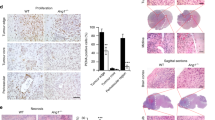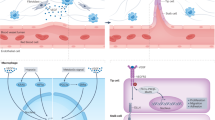Abstract
Recent discoveries of endogenous negative regulators of angiogenesis, thrombospondin, angiostatin and glioma-derived angiogenesis inhibitory factor, all associated with neovascularized tumours, suggest a new paradigm of tumorigenesis. It is now helpful to think of the switch to the angiogenic phenotype as a net balance of positive and negative regulators of blood vessel growth. The extent to which the negative regulators are decreased during this switch may dictate whether a primary tumour grows rapidly or slowly and whether metastases grow at all.
This is a preview of subscription content, access via your institution
Access options
Subscribe to this journal
Receive 12 print issues and online access
$209.00 per year
only $17.42 per issue
Buy this article
- Purchase on Springer Link
- Instant access to full article PDF
Prices may be subject to local taxes which are calculated during checkout
Similar content being viewed by others
References
Demicheli, R. et al. Local recurrences following mastectomy: support for the concept of tumor dormancy.J, natn. Cancer Inst. 86, 45–48 (1994).
Morrow, M. & Jordan, V.C. Risk factors and the prevention of breast cancer with tamoxifen. Cancer Surveys 18, 211–229 (1993).
Kripke, M.L. Immunoregulation of carcinogenesis: past, present, and future. J. natn. Cancer Inst. 80, 722–727 (1988).
Sugarbaker, E.V. Cancer metastasis: a product of tumor-host interactions. Curr. Prob. Cancer 3, 1–59 (1979).
Fider, I.J. & Ellis, L.M. Cell 79, 185–188 (1994).
Prehn, R.T. The inhibition of tumor growth by tumor mass. Cancer Res. 51, 2–4 (1991).
Folkman, J., Watson, K. Ingber & D. Hanahan, D. Induction of angiogenesis during the transition from hyperplasia to neoplasia. Nature 339, 58–61 (1989).
Kandel, J. et al. Neovascularization is associated with a switch to the export of bFGF in the multistep development of fibrosarcoma. Cell 66, 1095–1104 (1991).
Weidner, N., Semple, J., Welch, W. & Folkman, J. Tumor angiogenesis correlates with metastasis in invasive breast carcinoma. N. Engl. J. Med. 324, 1–8 (1991).
Folkman, J. Tumor angiogenesis. In: Mendelsohn, J., Howley, P., Liotta, L., Israel, M., eds. The Molecular Basis of Cancer, W.B. Saunders Company, Philadelphia, in press (1994).
Folkman, J. Angiogenesis and breast cancer. J. clin. Oncol 12, 441–443 (1994).
Nicosia, R.F., Tchao, R. & Leighton, J. Interactions between newly formed en-dothelial channels and carcinoma cells in plasma clot culture. Clin. exp. Metastasis. 4, 91–104 (1986).
Rak, J.W., Hegmann, E.J., Lu, C. & Kerbel, R.S. Progressive loss of sensitivity to en-dothelium-derived growth inhibitors expressed by human melanoma cells during disease progression. J. cell. Physiol. 159, 245–255 (1994).
Hamada, J., Cavanaugh, P.G., Lotan, O. & Nicolson, G. Separable growth and migration factors for large-cell lymphoma cells secreted by microvascular endothe-lial cells derived from target organs for metastasis. Br. J. Cancer 66, 349–354 (1992).
Rastinejad, F., Polveini, P.J. & Bouck, N.P. Regulation of the activity of a new inhibitor of angiogenesis by a cancer suppressor gene. Cell 56, 345–355 (1989).
Bouck, N.P. Tumor angiogenesis: the role of oncogenes and tumor suppressor gene. Cancer Cells. 2, 179–185 (1990).
Dameron, K.M., Volpert, O.V., Tainsky, M.A. & Bouck, N.P. Control of angiogenesis in fibroblasts by p53 regulation of thrombospondin-1. Science 265, 1582–1584 (1994).
Maciag, T., Mehlman, T., Friesel, R. & Schreiber, A. Heparin binds endothelial cell growth factor, the principal endothelial cell mitogen in bovine brain. Science 225, 932–935 (1984).
Shing, Y. et al. Heparin affinity: purification of a tumor-derived capillary endothelial cell growth factor. Science 223, 1296–1298 (1984).
Ferrara, N. & Henzel, W.J. Pituitary follicular cells secrete a novel heparin-binding growth factor specific for vascular endothelial cells. Biochem. Biophys. Res. Com-mun. 161, 851–855 (1989).
Fett, J.W. et al. Isolation and characterization of angiogenin, an angiogenic protein from human carcinoma cells. Biochem. 24, 5480–5486 (1985).
Folkman, J., Shing, Y., J. biol Chem. 267, 10931–10934 (1992).
O'Reilly, S. et al. Angiostatin: A novel angiogenesis inhibitor that mediates the suppression of metastases by a Lewis lung carcinoma. Cell 79, 315–328 (1994).
Van Meir, E.G. et al. Release of an inhibitor of angiogenesis upon induction of wild type p53 expression in glioblastoma cells. Nature Genetics 8, 171–176 (1994).
Poste, G. & Fidler, I.J. The pathogenesis of cancer metastasis. Nature 283, 139–146 (1980).
Zetter, B. The cellular basis of site-specific tumor metastasis. N. Engl. J. Med. 322, 605–612 (1990).
Holmgren, L., O'Reilly, M. & Folkman, J. in press (1994).
Takeshita, S. et al. A single intraarterial bolus of vascular endothelial growth factor augments revascularization in a rabbit ischemic hind limb model. J. clin. Invest 93, 662–670 (1994).
Shweiki, D., Itin, A., Soffer, D. & Keshet, E. Vascular endothelial growth factor induced by hypoxia may mediate hypoxia-initiated angiogenesis. Nature 359, 843–845 (1992).
Ferrara, N. personal communication (1994).
Yuhas, J.M. & Pazmino, N.H. Inhibition of subcutaneously growing line 1 carcinomas due to metastatic spread. Cancer Res. 34, 2005–2010 (1974).
Nanus, D. et al. Expression of basic fibroblast growth factor in primary human renal tumors: correlation with poor survival. J. natn. Cancer Inst. 85, 1597–1599 (1993).
Nguyen, M. et al. Elevated levels of an angiogenic peptide, basic fibroblast growth factor, in the urine of patients with a wide spectrum of cancers. J. natn. Cancer Inst. 86, 356–361 (1994).
Kohn, E. et al. Phase I trial of signal transduction inhibitor, CAI. Proc. Amer. Assoc. Cancer Res. 35,244(1994).
Liotta, L.A. personal communication (1994).
Folkman, J. Clinical applications of angiogenesis research. New Engl. J. Med. in press (1994).
Watanabe, H., Nguyen, M., Schizer, M., Li, V., Hayes, D.R., Sallan, S., Folkman, J. Basic fibroblast growth factor in human serum – a prognostic test for breast cancer. Molec. Biol. Cell 3, 324a (1992).
Li, V.W. et al. Microvessel count and cerebrospinal fluid basic fibroblast growth factor in children with brain tumors. The Lancet 344, 82–86 (1994).
Weidner, N. et al. Tumor angiogenesis: A new significant and independent prognostic indicator in early-stage breast carcinoma. J. natn. Cancer Inst. 84, 1875–1887 (1992).
Weidner, N., Carroll, P.R., Flax, J., Blumenfeld, W. & Folkman, J. Tumor angiogenesis correlates with metastasis in invasive prostate carcinoma. Amer. J. Pathol. 143, 401–409 (1993).
Teicher, B.A. et al. Potentiation of cytotoxic cancer therapies by TNP-470 alone and with other anti-angiogenic agents. Int. J. Cancer. 57, 920–925 (1994).
Schaper, W., Schaper, J. Collateral Circulation: Heart, Brain, Kidney, Limbs. Kluwer Academic Publishers, Boston, (1993).
Miller, J.W. et al. Vascular endothelial growth factorJVascular permeability factor is temporally and spatially correlated with ocular angiogenesis in a primate model. Amer. J. Pathol 145, 574–584 (1994).
Adamis, A.P. et al. Increased vascular endothelial growth factor levels in the vitreous of eyes with proliferative diabetic retinopathy. Amer. J. Ophthal. 118, 445–450(1994).
Takahashi, K. et al. Cellular markers that distinguish the phases of hemangioma during infancy and childhood. J. clin. Invest. 93, 2357–2364 (1994).
Peacock, D.J., Banquerigo, M.L. & Brahn, E. Angiogenesis inhibition suppresses collagen arthritis. J. exp. Med. 175, 1135–1138 (1992).
Nickoloff, B.J., Mitra, R.S., Varani, J., Dixit, V.M. & Polerini, P.J. Aberrant production of interleukin-8 and thrombospondin-1 by psoriatic keratinocytes mediates angiogenesis. Amer. J. Pathol 44, 820–828 (1994).
Bacharach-Buhles, M., Panz, B., Elgammal, S., Auer, T. & Altmeyer, P. The elongation of psoriatic capillaries, the result of epidermal hyperplasia, not of angiogenesis. J. Invest. Dermatol. 103, 263 (1994).
Szabo, S. Animal model: cysteamine-induced and chronic duodenal ulcer in the rat. Amer. J. Pathol 93, 273–276 (1974).
Szabo, S. et al. Orally administered FGF mutein: Effect on healing of chronic duodenal ulcers in rats. Digestive Disease and Sciences 34, 1323 (1989).
Folkman, J. et al. Duodenal ulcer: discovery of a new mechanism and development of angiogenic therapy which accelerates healing. Ann. Surg. 214, 414–427 (1991).
Hull, M.A., Cullen, D.J.E. & Hawkey, C.J. Basic fibroblast growth factor in gastric ulceration: mucosal levels and therapeutic potential. Gastroenterology 106, A97 (1994).
Dvorak, H., Wounds that do not heal. Similarities between tumor stroma generation and wound healing. N. EnglJ. Med. 315, 1650–1659 (1986).
Wolfe, M.M. et al. Safety and efficacy of an angiogenic peptide, basic fibroblast growth factor (bFGF) in the treatment of gastroduodenal ulcers: A preliminary report. Gastroenterology 106, A212 (1994).
Folkman, J. Angiogenesis in female reproductive organs. In: Steroid Hormones and Uterine Bleeding. Alexander, N.J., d'Arcangues, C., eds. American Association for the Advancement of Science Press, Washington DC, 144–158 (1992).
Ravindranath, N., Little-Ihrig, L., Philips, H.S., Ferrara, N. & Zeleznik, A. Vascular endothelial growth factor messenger ribonucleic acid expression in the primate ovary. Endocrinology 131, 254–260 (1992).
Redmer, D.A., Kirsch, J.D. & Reynolds, L.P. Production of mitogenic factors by cell types of bovine large estrogen-active and estrogen-inactive follicles. J. Anim. Sci. 69, 237–245 (1991).
Reynolds, L.P., Killilea, D.S. & Redmer, D.A. Angiogenesis in the female reproductive system. FASEB 6, 886–892 (1992).
Greenwald, G.S. Temporal and topographic changes in DNA synthesis after induced follicular atresia. Biol. Reprod. 40, 175–181 (1989).
Folkman, J. What is the evidence that tumors are angiogenesis dependent? J. natn. Cancer Inst. 82, 4–6 (1990).
D'Amato, R.J., Loughnan, M.S., Flynn, E. & Folkman, J. Thalidomide is an inhibitor of angiogenesis. Proc. natn Acad. Sci.USA 91, 4082–4085 (1994).
Risau, W. & Ekblom, P. Production of a heparin-binding angiogenesis factor by the embryonic kidney. J. cell Biol 103, 1101–1107 (1986).
Millauer, B. et al. High affinity VEGF binding and developmental expression suggest Flk-1 as a major regulator of vasculogenesis and angiogenesis. Cell 72, 835–846(1993).
Poole, T.J. & Coffin, J.D. Vasculogenesis and angiogenesis - two distant morpho-genetic mechanisms establish embryonic vascular pattern. J. exp. Zool 251, 224–231 (1989).
Liotta, L., Kleinerman, J. & Saidel, F. Quantitative relationships of intravascular tumor cells, tumor vessels, and pulmonary metastases following tumor implantation. Cancer Res. 34, 997–1004 (1974).
Brem, H., Goto, F., Budson, A., Saunders, L. & Folkman, J. Minimal drug resistance after prolonged antiangiogenic therapy with AGM-1470. Surgical Forum XLV, 674–677 (1994).
Plate, K.H., Breier, G., Welch, H.A. & Risau, W. Vascular endothelial growth factor is a potential tumour angiogenesis factor in human gliomas in vivo. Nature 359, 845–848, (1992).
Kerbel, R.S. Inhibition of tumour angiogenesis as a strategy to circumvent acquired resistance to anticancer therapeutic agents. BioEssays 13(1), 31–36 (1991).
Crowley, N.J. & Siegler, H.F. Relationship between disease-free interval and survival in patients with recurrent melanoma. Arch. Surg. 127, 1303–1308 (1992).
Ezekowitz, R.A.B., Mulliken, J.B., Folkman, J. Interferon alfa-2a therapy for life-threatening hemangiomas of infancy. New Engl. J. Med. 326, 1456–1463 (1992) (and corrections New Engl J. Med. 33, 300 (1994)).
Folkman, J. et al. (unpublished data).
O'Reilly, M.S. et al. (unpublished data).
Author information
Authors and Affiliations
Rights and permissions
About this article
Cite this article
Folkman, J. Angiogenesis in cancer, vascular, rheumatoid and other disease. Nat Med 1, 27–30 (1995). https://doi.org/10.1038/nm0195-27
Issue Date:
DOI: https://doi.org/10.1038/nm0195-27
This article is cited by
-
Systemic immune-inflammation index and in-stent restenosis in patients with acute coronary syndrome: a single-center retrospective study
European Journal of Medical Research (2024)
-
Group XIV C-type lectins: emerging targets in tumor angiogenesis
Angiogenesis (2024)
-
Gold nanoparticle conjugation and tumor accumulation of a VEGF receptor-targeting peptidomimetic
Journal of the Iranian Chemical Society (2024)
-
c-MYC mediates the crosstalk between breast cancer cells and tumor microenvironment
Cell Communication and Signaling (2023)
-
Disease specific urinary biomarkers in the central nervous system
Scientific Reports (2023)



